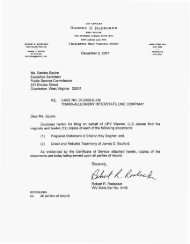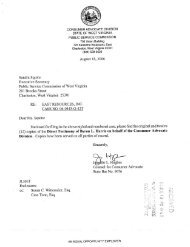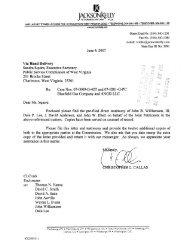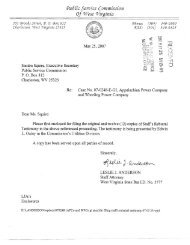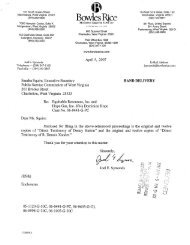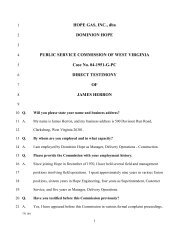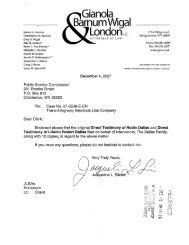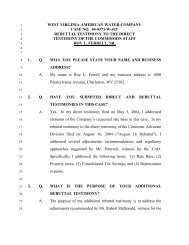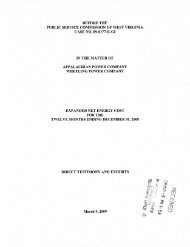Direct Testimony of Thomas M. Hildebrand - Consumer Advocate ...
Direct Testimony of Thomas M. Hildebrand - Consumer Advocate ...
Direct Testimony of Thomas M. Hildebrand - Consumer Advocate ...
Create successful ePaper yourself
Turn your PDF publications into a flip-book with our unique Google optimized e-Paper software.
...--... I. VY, ,““Y I uvvcIllul - V V ~ d . L U I I I Page 2 <strong>of</strong> 3<br />
or utilities and help them automatically go into energy-saver mode. EnerNOC Inc. <strong>of</strong> Boston,<br />
which went public in May, had 1,852 locations signed as <strong>of</strong> June 30, more than triple the number<br />
the prior year, giving EnerNOC 756 megawatts <strong>of</strong> customer load under management, up from 234<br />
megawatts.<br />
One participant is Stop & Shop Supermarket Co., a unit <strong>of</strong> Netherlands supermarket giant Ahold<br />
NV. The chain is able to cut energy use by 40 megawatts when asked, an amount <strong>of</strong> power equal<br />
to the output <strong>of</strong> what is known as a peaker plant ”. that otherwise might be fired up to meet high<br />
demand, through various measures.<br />
. --<br />
/-<br />
*I At Exelon Corp.5 Commonwealth Edison Co., Chicago, 2,173 business locations have signed up<br />
f<br />
for utility programs this year in which they, collectively, are paid to cut use by 647 megawatts.<br />
That compares with 22 sites totaling 25 megawatts last year. Customers decide when to cut energy<br />
’<br />
use. not utility or grid <strong>of</strong>ficials, and it is <strong>of</strong>ten based on the market price <strong>of</strong> power they will<br />
L e c e . */+c<br />
~-~---.--“~,..~*.-,~.-~-nl_-g-<br />
_-<br />
___c__~L_ II_ nrnl<br />
.)_ *,.“.-.-,e-<br />
I- ---e@--<br />
Some firms shift production to times when power costs are lower or ratchet back lighting and air<br />
conditioning.<br />
“Customers are becoming much more energy conscious,’’ says Sharon Hillman, vice president <strong>of</strong><br />
marketing and environmental programs at ComEd that soon will have one <strong>of</strong> the largest “demand<br />
response” programs outside <strong>of</strong> California.<br />
In the Midwest and mid-Atlantic states, a slew <strong>of</strong> programs has attracted the participation <strong>of</strong><br />
scores <strong>of</strong> firms with the promise <strong>of</strong> rewards. Big energy users cut electricity usage by nearly 2,000<br />
megawatts on Aug. 8, a day when supplies were stretched thin in the multistate area where power<br />
flows are managed by PJM Interconnection LLC.<br />
The conservation effect in California looks like the strongest since 200 1, when the state had<br />
rolling blackouts because <strong>of</strong> power shortages and illegal market activity. In the aftermath <strong>of</strong> that<br />
crisis, the state encouraged construction <strong>of</strong> more gas-fired power plants and renewable energy<br />
resources. That effort has been superceded by a policy that seeks to <strong>of</strong>fset market growth by<br />
giving consumers tools to cut use, in some cases by replacing inefficient older equipment,<br />
installing smart controllers or changing patterns <strong>of</strong> use.<br />
The ability to change usage, typically away from high-priced or grid-stressed periods, is called<br />
“demand response,” and it is especially important because California is introducing a new method<br />
for pricing wholesale electricity in April 2008, capping an eight-year market-overhaul effort. The<br />
Federal Energy Regulatory Commission, which oversees wholesale electricity markets, has urged<br />
state <strong>of</strong>ficials to help users gain influence in the market, not just as consumers but as those who<br />
can put <strong>of</strong>f or eliminate consumption.<br />
Grid <strong>of</strong>ficials are finding that it pays to have a variety <strong>of</strong> programs in the field. The California<br />
Independent System Operator, which runs most transmission lines in the state and reports to<br />
FERC, has arrangements in place that give it 2,300 megawatts worth <strong>of</strong> customer demand it can<br />
call upon in an emergency. But it wants to develop a capability to tap an even larger universe <strong>of</strong><br />
companies and not just when there are emergencies but as a counterweight to high prices.<br />
The Cal-IS0 has set up a Demand Response Lab to study the best technologies available. It would<br />
like to have a vast cadre <strong>of</strong> energy users able to cut consumption as easily and quickly as



